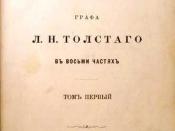One of the key issues in recent translation theories has been on whether translation should domesticate or foreignize the source text. Venuti (1995) defines domesticating translation as a replacement of the linguistic and cultural difference of the foreign text with a text that is intelligible to the targetlanguage reader. Foreignizing translation is defined as a translation that indicates the linguistic and cultural differences of the text by disrupting the cultural codes that prevail in the target language. Other scholars, like Tymoczko (1999), criticise this dichotomy by pointing out that a translation may be radically oriented to the source text in some respects, but depart radically from the source text in other respects, thus denying the existence of the single polarity that describes the orientation of a translation.
I have chosen five English translations of Lev Tolstoy's Anna Karenina for my paper. Dole (1886),Garnett (1901), Maude (1918), Edmonds (1954) and Pevear and Volokhonsky (2000).
My main objective has been to analyse the relationship between earlier and latertranslations. Since modern English language readers are more familiar with Russianlanguage, literature and culture as well as with Tolstoy's works than the 19th centuryreaders were, theoretically speaking, translating Tolstoy in 2000 should be easier than itwas in 1886. In reality each translator still had to choose between the adequaterepresentation of Tolstoy's text and the acceptability of their translation for theircontemporary English speaking audiences (the terms described in Toury 1995) on asliding scale between audience and text. In a way, with the higher development of the artand scholarship of translation, the expectations of readers and critics grow, and adequaterepresentation of a text in a different language becomes more challenging. My hypothesisis that literary translation evolves as an exploration of deeper and deeper layers of thesource text. In the present thesis I try to show how the history of translation of AnnaKarenina into English reflects these different stages of evolution.
One of the key issues in the recent translation theories has been on whether thetranslator should remain invisible. The term invisibility describes the extent to whichcertain translation traditions tolerate the presence (i.e. intrusion, intervention) of thetranslator in the translation (Hatim 2001, 45). This term originated in the works ofLawrence Venuti, himself a literary translator since the late 1970s. Venuti suggests that'invisibility' reveals itself in two related phenomena:The 'effect of discourse', that is, the translator's use of language.
In this paper I am going to explore the relationship between foreignization anddomestication in translations of Anna Karenina into English. Henry Gifford points out that 'Tolstoy's readers in the English language are not greatly outnumbered by those who read him in Russian' (Gifford 1978, 17). There have been at least ten translations of AnnaKarenina into English, covering over a century of the history of literary translation.
Gifford points out that with so many readers depending on the English translation for their knowledge of a very important writer, the question of how to communicate his effect is quite as central nowadays as that of how to represent Homer was for Matthew Arnold when he wrote his famous essay On Translating Homer (Ibid. 17.) It is therefore worth trying to establish certain parallels between successive translations of classic authors and successive translations of Russian classics.
Venuti describes the history of translation theory as a set of changing relationships between the translator's actions and the concepts of equivalence and function. Equivalence is defined as a 'variable notion ' of the connection between the original text and its translation and function is 'a variable notion' of how the translated text is connected to the receiving language and culture.
(Venuti 2000b, 5).
A diachronic study of translation history undoubtedly requires a period classification. George Steiner (1975) believes that the whole history of translation theory could be divided into four periods. The founder of the translation theory as a specific was a French humanist Etienne Dolet, who was strangled and burned with his books, for adding the phrase rien du tout in Plato's passage about what existed after death, which implied doubts about immortality.
The translator must fully understand the sense and meaning of the original author,although he is at liberty to clarify obscurities. The translator should have a perfect knowledge of both source language and target language. The translator should avoid the tendency to translate word-for-word renderings. The translator should use forms of speech in common use.
The translator should choose and order words appropriately to produce the correct tone (Cit. Bassnett 1980, p.54). Dolet's principles are clearly domesticating, already in the first principle he gives translators the liberty to clarify obscurities in the original and make their texts clear for common readers.
Gifford refers to Tolstoy's repetitions as 'links in the system of linkings' and points out that 'since the chain is no stronger than its weakest link, the blurring of episodes will diminish the effect of the whole novel'. By that he means that 'when Tolstoy's moral vocabulary is so spare, reduced to the bedrock essentials, something of the novel's steady, even obsessive preoccupation is lost should the translator retreat however slightly from singleness of meaning' (Gifford 1978, 26-27).
If a translator sees repetitions as redundant, domesticating strategy will be toreduce the number of repetitions 'for the sake of a facile elegance' (Matlaw 1976, 736),which can result in a leveling of narrative style. Foreignizing strategy will preserve therepetitions and produce a possibly less elegant language text. As May (1994, 59) pointsout, translators sometimes work to reflect peculiarities of certain characters' speech intheir English prose, since those peculiarities contribute to the readers' understanding of the character; but when the individualities of speech do not belong to a character, when they are offering a generalised sense of the narrating voice, then they often disappear altogether in translation. Because of this kind of 'correction', readers of Tolstoy's works in English are less likely to appreciate the significant role repetition plays in Tolstoy's writing (Sankovitch)A few examples of different translations:''However, I don't agree with you,'' said the voice.' (Dole, 70)''All the same I don't agree with you,' said the lady's voice.' (Garnett, 69)''All the same I don't agree with you,' the lady was saying.' (Maude, v.1,69)''All the same I don't agree with you,' said the lady's voice.' (Edmonds,75)''I still don't agree with you,' the lady's voice said.' (Pevear, 62)In example a) the construction is changed in Garnett's translation where shechanges the narrative focus from Kitty to Dolly and therefore makes the reader focus onDolly's feelings for longer than Tolstoy's reader does. Dole changes the construction inexample b) to Levin's point of view and therefore misses the moment where Kitty seesLevin and includes him in her inner life - to which a minute before that he was stranger.
Only Dole and Pevear keep Tolstoy's construction intact in example c). When Maudechanges 'said Kitty's voice' for 'asked Kitty', he destroys the narrative effect that showsLevin so absorbed in his thoughts that he does not notice Kitty at the terrace until shestarts speaking to him. Similarly, in example d) Maude does not preserve the effect ofVronsky hearing Anna's voice but not being able to see her. He consistently changes theconstruction in these two sentences, not attempting equivalence with Tolstoy's style.
In a target language oriented translation adapting the text to the moral norms of the target culture could either involvem expurgation or, in a freer society, over-clarification, i.e. rendering clear what was meant to be slightly disguised in the original. In a source language oriented translation the text is neither bowdlerised nor over-clarified.
Venuti shows that translator's refusal to bowdlerise a text is a way of opposingdomesticating tendencies within the target culture. He does so, using the example of JohnNott, who in the 18th century refused to omit explicit sexual references in Catullus'spoetry, explaining that(â¦) when an ancient classic is translated, and explained, the work may be considered as transforming a link in the chain of history: history should not be falsified, we ought therefore to translate him fairly; and when he gives us the manners of his own day, however disgusting to our sensations, and repugnant to our natures they may sometimes prove, we must not endeavour to conceal, or gloss them over. (Cit. Venuti 1994, 85)There are several ways in which translators can bowdlerise a text: omittingreferences to sexual relations is by far the most common. Other ways include using a more neutral word (a euphemism) or replacing the original references to sexual relations with those acceptable within the target culture. For instance, Walter Kelly commented in 1861 that when translating Tibullus's elegy about homosexual love, he had been 'compelled to be unfaithful to the original with regard to gender' (Mason 2000, 515).
One example of Victorian Puritanism, noted by Nabokov, has already been cited inthe first chapter. When, in Dole's translation, Vronsky asks Anna what is the matter withher, Anna responds in Russian: Ya beremenna! (Dole, 200), 'all because the translatorthought that "I am pregnant" might shock some pure soul'. (Nabokov 1981, 316) In theend of Dole's translation, in the glossary of Russian words and phrases "Ya beremenna" is translated as 'I am expecting my confinement'.
When Anna Karenina was first published in America, an anonymous critic wrotein Literary World: ' (â¦) on these relations of the sexes, on the facts of parentage andmotherhood, the book speaks with a plainness of meaning, sometimes with a plainness ofwords, which is at least new.' (Cit. Knowles 1978, 341) There are other omissions Dolemakes in order to adapt Tolstoy's 'plainness of words' to the moral norms of the Victorian society. For instance, when Anna becomes Vronsky's mistress, she starts seeing a recurrent nightmare that both Vronsky and Karenin are her husbands.
Garnett translated Anna Karenina fifteen years later than Dole, and during thosefifteen years Tolstoy's popularity in the English-speaking world had grown sufficiently tomend the 'Puritan taste' in translation (see chapter 2). Garnett was English, and, unlike the United States, England had its own 19th century strong tradition of the realistic novel,whilst American realism of the 1880s was 'mostly aloof from the homely and painfulrealities of life' (Ahnebrink 1961, 19). Also, being a woman with liberated attitudes torelationships and a mother herself, Garnett did not feel a need to omit the themes of sexual relationships and pregnancy. She, too, had some Victorian prudishness about language (see May 1994, 39), but examples of expurgation in her translation of Anna Karenina are rare. For example, in the sentence already quoted in chapter 3, in Garnett's translation, the nurse covers her bosom (Garnett, 477), which is definitely an advance from Dole's translation, where she just fastens her dress (Dole, 429). The bosom becomes 'welldeveloped breast' in Maude's translation and then 'large breast' in Edmonds' translation, as Tolstoy originally intended.
As suggested above, adapting the text to the moral norms within the target culturemay mean expurgation or, in a freer society, it can involve over-over-clarification, i.e. rendering clear what was not meant to be absolutely clear in the original.
Introducing Tolstoy's novels to English readers, Maude wrote:The dignity of man is hidden from us either by all kinds of defects or by the factthat we esteem other qualities too highly and therefore measure men by their cleverness,strength, beauty, and so forth. Tolstoy teaches us to penetrate beneath their externality.
(Maude 1929, 429)English translators have generally managed to recreate Tolstoy's lyrical lines. Forinstance, below is Garnett's translation of the first passage, quoted in 4.12:She did not look out again. The sound of the carriage-springs wasno longer audible, the bells could scarcely be heard. The barking of dogsshowed the carriage had reached the village, and all that was left was theempty fields all round, the village in front and he himself isolated and apartfrom it all, wandering lonely along the deserted high-road. (Garnett, 314-315.)The least lyrical is the Maude translation of the same paragraph:She did not look out again. The sound of the wheels could no longerbe heard; the tinkling of the bells grew fainter. The barking of dogs provedthat the coach was passing through the village, and only the empty fields,the village before him, and he himself walking solitary on the desertedroad, were left. (Maude v.1, 315) I believe, the lack of lyricism in this translation is mainly due to two facts:Maude changes Tolstoy's syntactic construction, putting the verb 'left' in the end of the last sentence and he leaves out the group of words defining Levin's emotionalstate: 'isolated and apart from it all'. The word 'prove' also sounds unnecessarilyscientific in this context.
Anna Karenina is, of course, written in prose, and therefore a detailed essay ontranslating poetry would be out of place here. When the characters of Anna Kareninaoccasionally quote poetry lines, it becomes more of a problem of literary allusions andliteral quotations. The poetry lines they quote become part of their voice, and they reflecttheir background, tastes, etc. As Christian (1978, 5) comments, many translators, even ifthey know both English and Russian fluently, have lacked a proper background knowledge of Russian literature and history. He therefore suggests that the best English translations of Russian fiction are being done by professors and lecturers in British and American universities.
Bibliography:Aaltonen, Sirkku (2000.) /Time-sharing On Stage/ Clevedon: Multilingual matters.
Abdulla, Adnan (1992.) Translation of Style/ /In Robert de Beaugrande, Language, Discourse andTranslation in the West and Middle East. Amsterdam, John Benjamins publishing company: 65-72.








